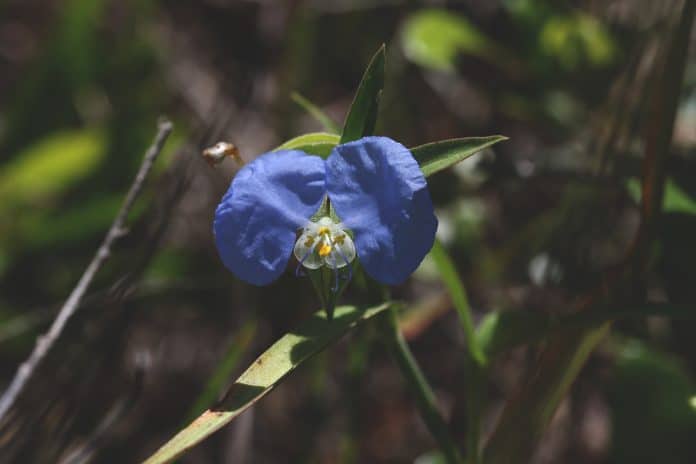As this concludes the spring series of Walk on the Wildside, Lilly and I hope you have enjoyed learning about some of the beautiful and wonderful native flowering plants that thrive in Hernando County.
Whether you are hiking one of Hernando County’s awesome trails through the Withlacoochee State Forest, visiting a preserve or park, take the time to admire nature’s wildflowers.
Whitemouth Dayflower (Commelina erecta)
The Whitemouth Dayflower is a popular and common wildflower found throughout the Southeastern US. She is one of the beauties on display at the Ladybird Johnson Wildflower Center in Austin, Texas. Native to Florida, this spiderwort variety likes coastal upland and pine woodland areas. It can grow up to about 18 inches tall. The bottom petal is white, resembling a white mouth, and the two purple petals above resemble ears. It is considered a day flower because it closes up its blooms in the afternoon. Pollinators of all sorts, especially bees, love this native beauty, and gopher tortoises munch on the leaves. It is not often found for sale in native nurseries, as it prefers to choose your yard on its own. If it takes up residence, you’ll be happy to let it make itself at home. Once established, you can try your hand at separation and transplanting.
Largeflower Rose Gentian (Sabatia grandiflora)
Largeflower Rose Gentian or Largeflower Marsh Pink is one of the dozens of Marsh pinks found in Florida. This native likes to make a scene, though, with its showy purple flowers that dance on the end of a slender, two-foot stalk. The show lasts for days before the bloom begins to fade, and there are always other blooms nearby to draw attention. This flashy beauty loves very moist areas bathed in sunlight. One of the stunning features is the star inside of the purple flower. Look in the center, and you will see a yellow star shape at the base of the petals, outlined in red. She is quite proud of her beauty and blooms all summer in Central and North Florida, and all year in South Florida. This wetland beauty is nearly endemic to Florida. She does favor one Alabama county with her presence. She is alluring to pollinators of all sorts, and even the prey of certain insects are so sure of her magnetic force, they wait at the flowers for a dinner for themselves. This diva of the wetlands is at home in a marsh habitat and isn’t offered by nurseries for home gardening. She can’t be tamed and insists you come to her house if you’d like to bask in her beauty.
Florida Feathershank (Schoenocaulon dubiua)
In sharp contrast to the flashy natives previously discussed in this article, Florida Feathershank stays out of the limelight. In fact, it is easy to overlook this plain Jane. One must be committed to getting close to this little darling to find out her secrets. Along with the stalks of this member of the lily family, you will find blooms that seem to be stacked along the stem, and that are little firecrackers of purple bloom and white stamens with yellow tips. Endemic to Florida and Georgia, components of the Schoenocaulon family of plants have been used in organic pesticides. This unassuming lily is found in dunes and pine woodlands.
Pitted Stripeseed (Piriqueta cistoides)
Little bright rays of sunshine, Pitted Stripeseed blooms bring a splash of happiness to dry upland areas. They get to be 8 inches to 12 inches tall, but the stalk may be measured longer. It trails along the ground before it props up to display the five-petal flowers. The stalks are not very strong, and they tend to fall easily. Upon inspection, you will find the petals creped in lines; hence the term “pitted” in their common name. This happy plant can be overlooked in a display of mixed wildflowers, especially if it isn’t planted up front and center. The Gulf Fritillary butterfly will always find this yellow joy, though, as it is one of their host plants.
Eustis Lake Beardtongue (Penstemon australis)
A small, sassy snapdragon, Eustis Lake Beardtongue is a prolific bloomer. Each plant can produce a dozen stalks, which in turn, can produce a dozen blooms. This light purple delight is one of three native snapdragons in Florida. It can be found sticking out its sassy tongue in sandhills and open woodlands. The tubular flowers have hairs at the bottom, which account for the “beard.” The beard guides insect pollinators to the beautiful petals. Bees, wasps, and even hummingbirds stop by to pollinate these wild, snappy, snapdragons.
Feature: Ticktrefoils (Genus Desmodium)
We have all had a close encounter with this plant. Nature took the legume seeds, flattened them, and made them into sticky runners, which break off on whoever or whatever is passing by. Surely, you have spent time removing them from your shoes, socks, pants, sleeves, and dogs. You are already annoyed when I discuss these “hitchhikers” aren’t you? You must admit, Ticktrefoils have developed an ingenious way to spread around. Non-native species mix with native species, and sometimes they are difficult to differentiate. Although considered a pesky weed to crop growers and irritated walkers, it does have amazing flowers that serve as the larval host for the gray hairstreak, long-tailed skipper, doranes longtail, hoary edge, southern cloudywing, and the northern cloudywing. Now, isn’t it hard to stay mad at such a treasure to so many of our fluttery friends? Many legumes have a “ledge” on which the pollinator lands and triggers the flower to open to be pollinated. This plant has that and actually changes color after pollination to signal that the shop is closed. Weed or wildflower, sometimes it’s just a point of view!
————————–
Have you enjoyed our series so far? Let us know by emailing Lilly Browning at [email protected]
————————-

